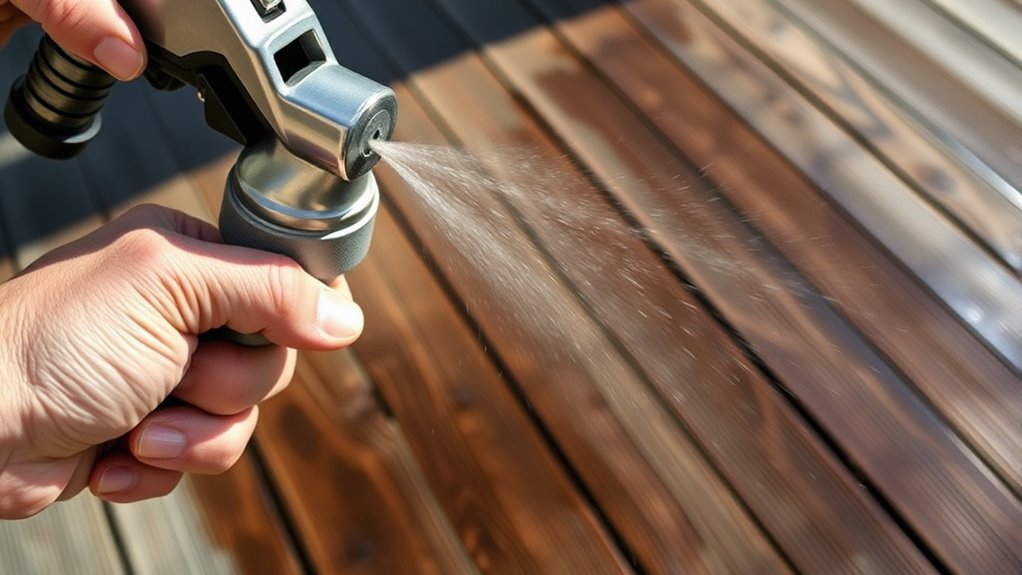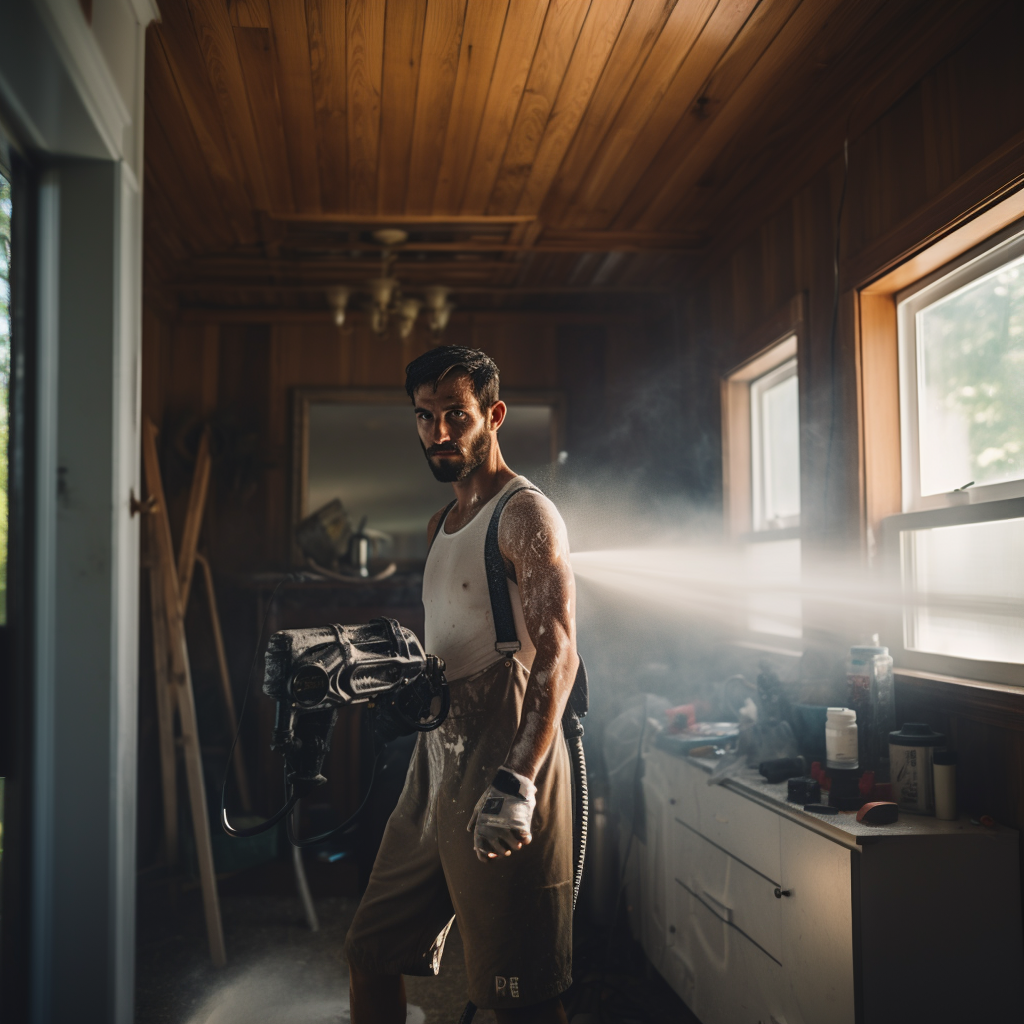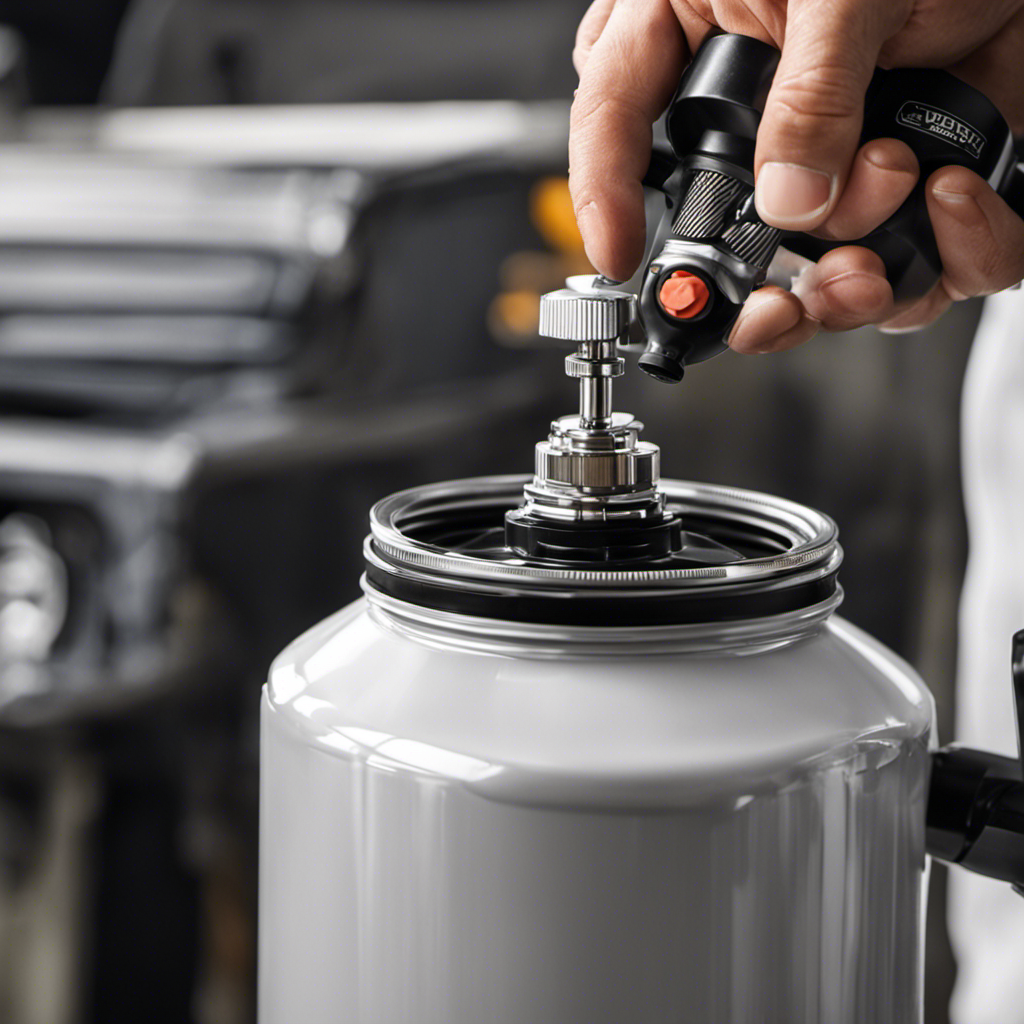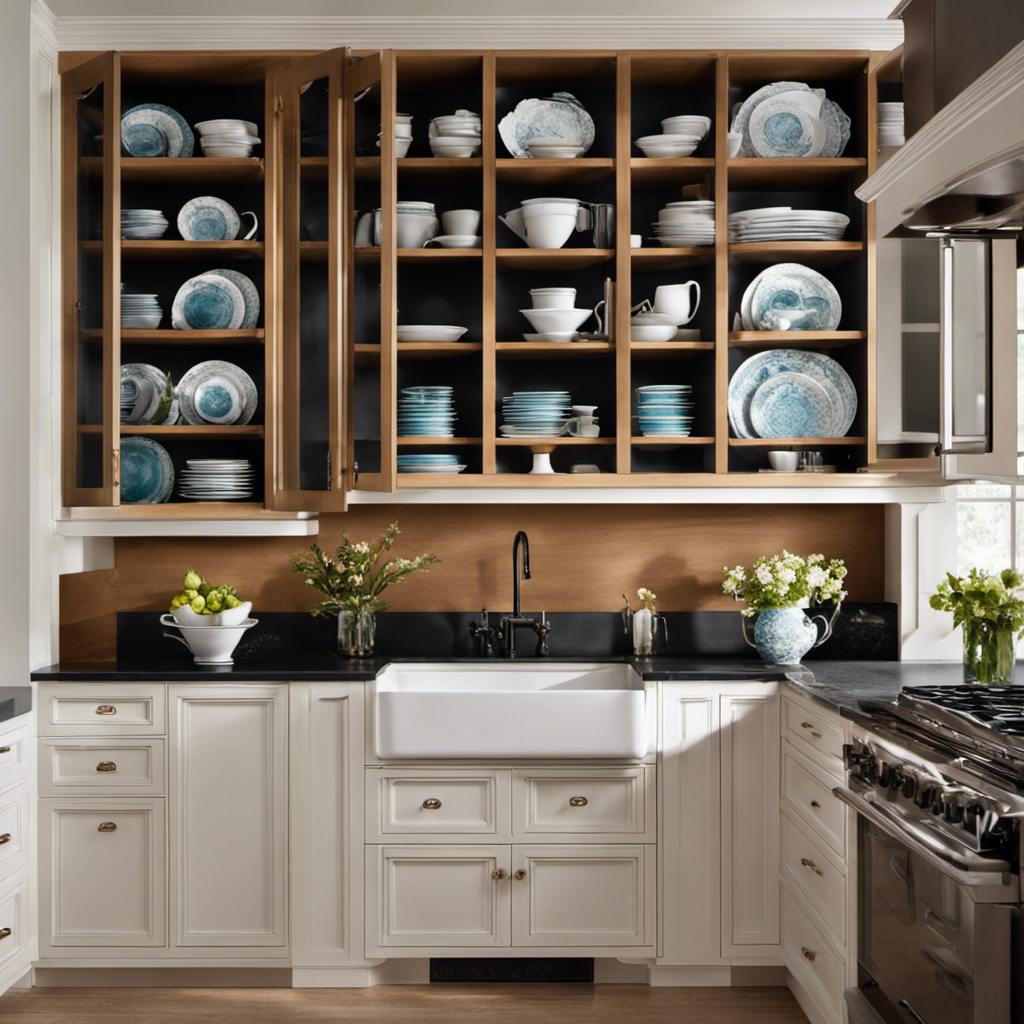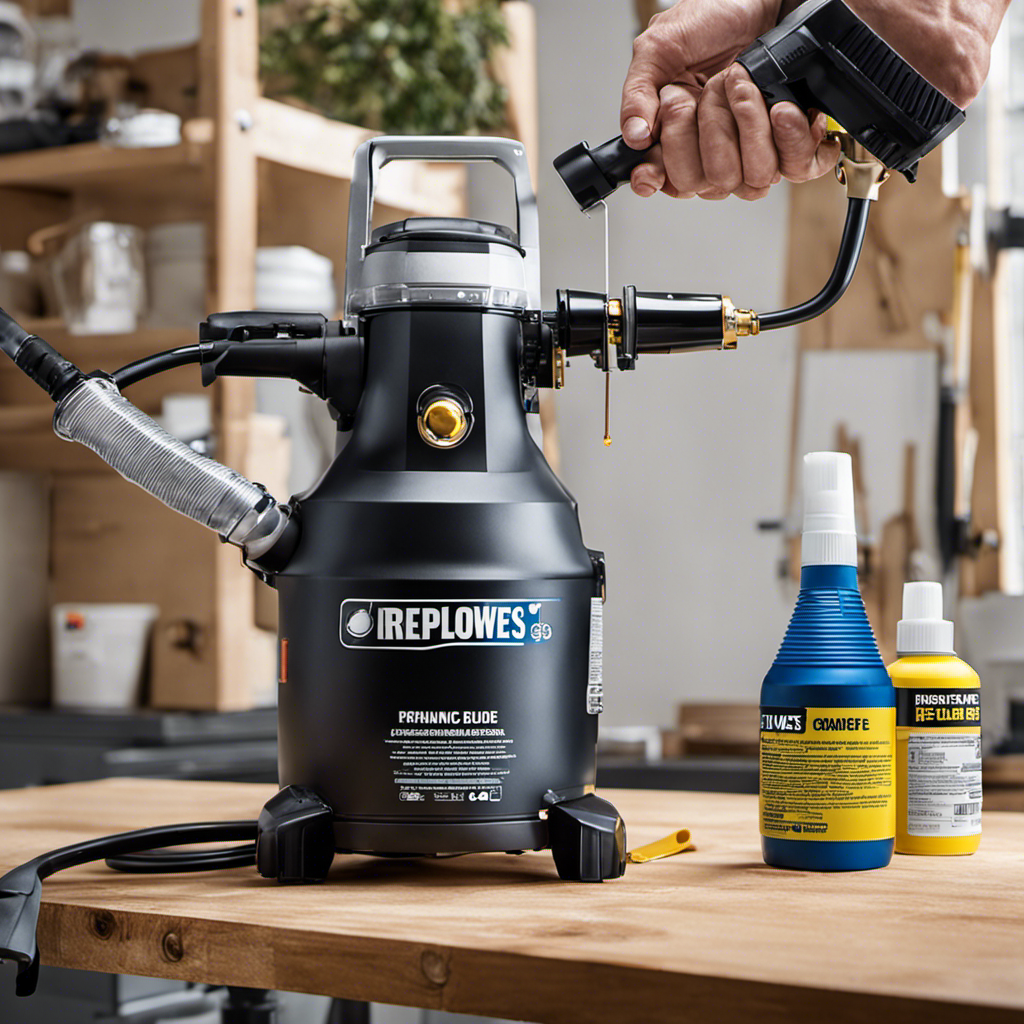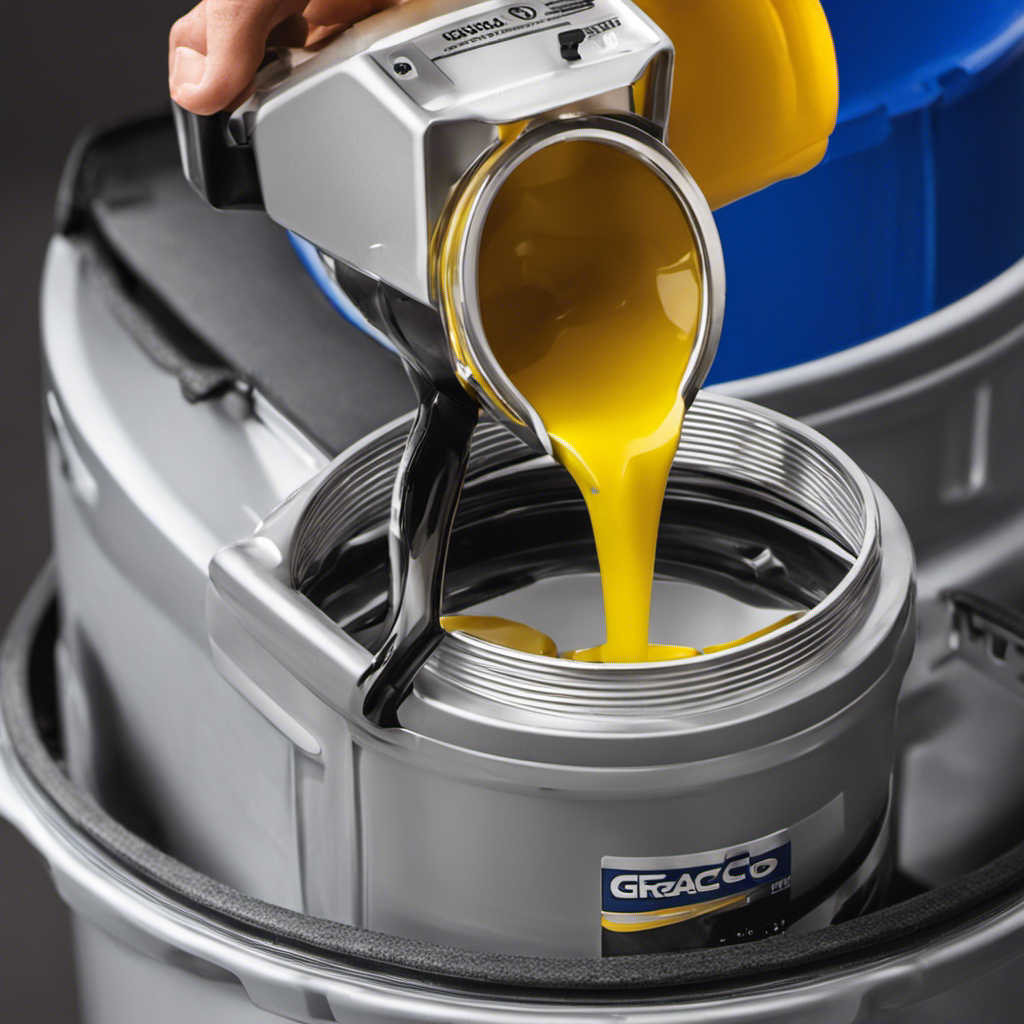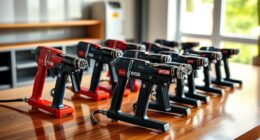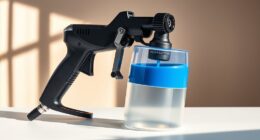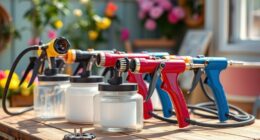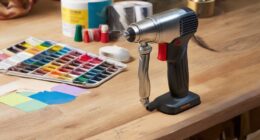Yes, you can use a paint sprayer for applying stain or polyurethane, but it’s important to select the right equipment and settings. HVLP sprayers work well for detailed finishes like stain, while airless sprayers are better for large areas and thicker coatings like polyurethane. Adjusting nozzle size, spray pattern, and pressure guarantees a smooth, professional result. If you want to master this technique, there’s more to learn about proper prep and application.
Key Takeaways
- Yes, paint sprayers can be used for staining and polyurethane applications with proper equipment adjustments.
- HVLP sprayers are ideal for precise staining and clear coats, while airless sprayers suit larger polyurethane projects.
- Match nozzle size to the material’s viscosity: smaller nozzles for stains, larger for polyurethane.
- Proper thinning of stains and polyurethanes ensures smooth spraying and prevents clogging.
- Regular cleaning and maintenance of the sprayer are essential for consistent, professional results.
Understanding the Differences Between Paint, Stain, and Polyurethane
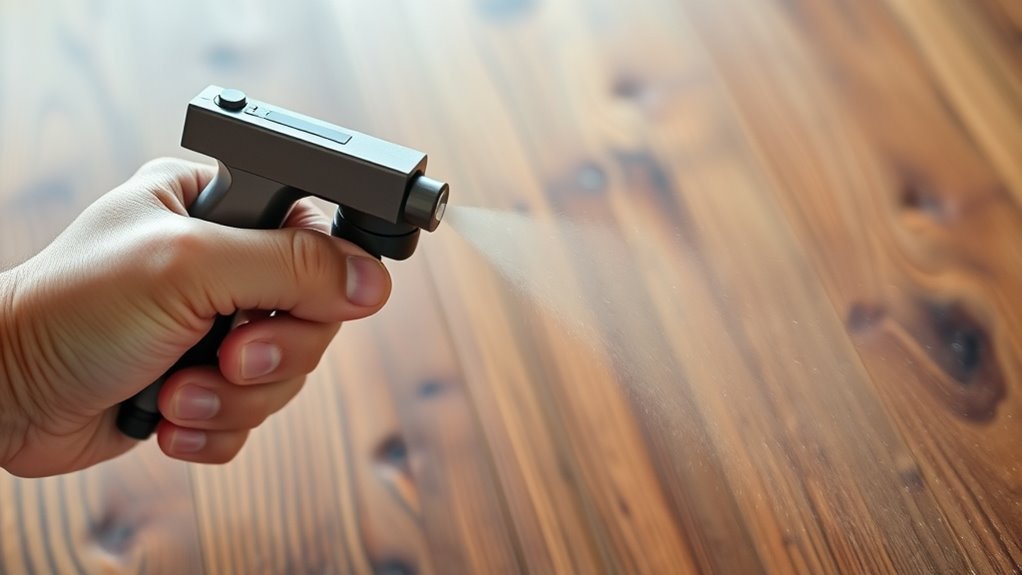
While paint, stain, and polyurethane are all used to finish wood surfaces, they serve different purposes and have distinct characteristics. When applying stain or polyurethane with a paint sprayer, your brush techniques matter because these finishes behave differently than paint. Stains penetrate the wood, so you want a light, even application to avoid blotches, and you’ll notice shorter drying times compared to paint. Proper application techniques are essential to achieve a smooth, professional finish. Rushing application or neglecting proper brush techniques can lead to uneven finishes or longer drying times. Additionally, selecting the appropriate spray equipment can significantly impact the quality of your results. Being aware of regional resources and choosing the right tools will help you achieve a smooth, professional look without unnecessary delays. Using the correct finishing products and understanding their properties will help ensure durability and aesthetic appeal. Understanding the properties of different finishes can guide you in selecting the best product for your project, leading to better results. By mastering these nuances, you’ll achieve a smooth, professional look without unnecessary delays.
Types of Paint Sprayers Suitable for Stain and Polyurethane
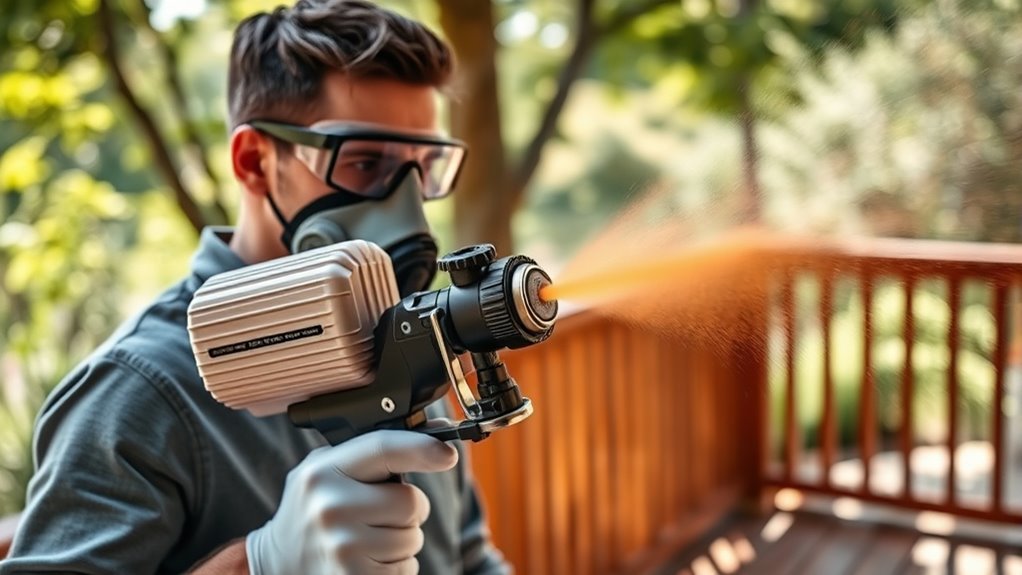
Choosing the right paint sprayer for stain and polyurethane depends on the project’s scale and the level of detail you want. HVLP (High Volume Low Pressure) sprayers are ideal for fine finishes, allowing you to master brush techniques and achieve smooth, even coats. Airless sprayers are better suited for larger surfaces, offering faster coverage but less control for detailed work. For color blending, a sprayer with adjustable settings helps you fine-tune spray patterns and thickness. Consider your experience level; beginners may prefer HVLP for its precision, while professionals might opt for airless for efficiency. Using the appropriate sprayer guarantees you can apply stain or polyurethane evenly, reducing drips and achieving professional results.
Preparing Your Paint Sprayer for Different Coatings
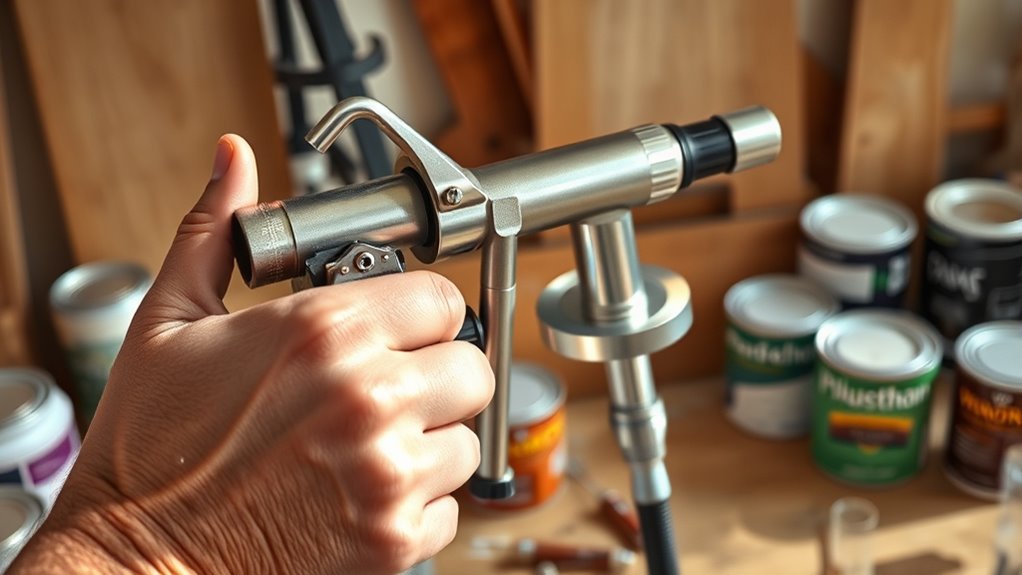
To achieve the best results, you need to prepare your paint sprayer properly for different coatings. Start by cleaning your sprayer thoroughly to prevent clogs. For stain or polyurethane, thin the coating if necessary, following manufacturer instructions. Practice different brush techniques to understand how the material flows. Keep in mind that drying times vary; stains typically dry faster than polyurethane. Use this table to visualize coating behaviors:
| Coating Type | Brush Technique | Drying Time |
|---|---|---|
| Stain | Light, sweeping | Shorter, quick cure |
| Polyurethane | Even, controlled strokes | Longer, slower cure |
Proper prep guarantees smooth application, minimizes runs, and achieves an even finish. Additionally, understanding the benefits of airless paint sprayers can help you choose the right equipment for applying these coatings efficiently. Knowing the different coating behaviors can further improve your application process and results.
Adjusting the Spray Pattern and Pressure Settings
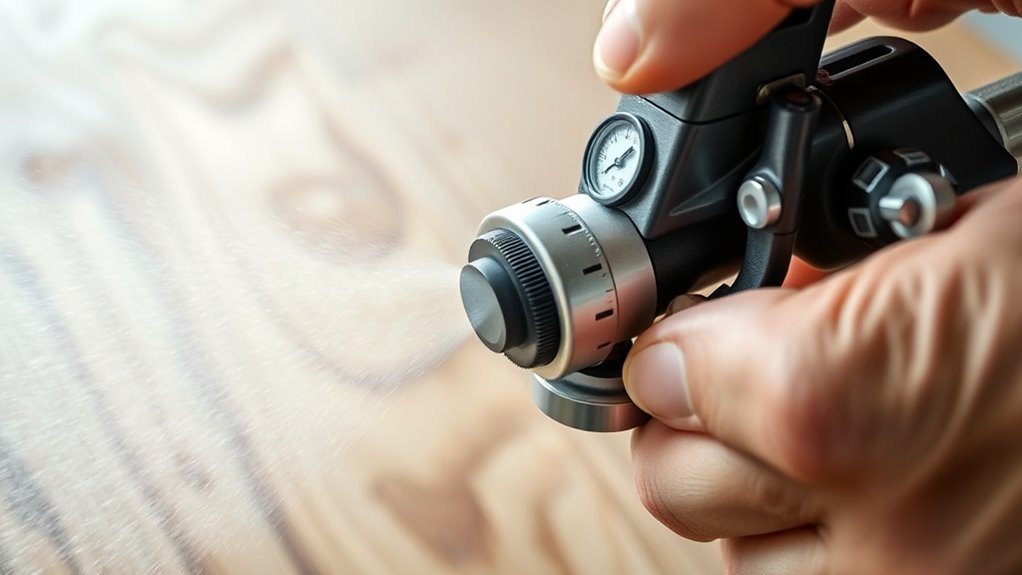
To get the best finish, you need to adjust your spray pattern and pressure settings correctly. You can change the pattern by tweaking the nozzle or selecting different settings, and your pressure controls how smoothly the coating sprays out. With proper adjustments, you’ll achieve even coats and a professional-looking result.
Pattern Adjustment Techniques
Adjusting the spray pattern and pressure settings is essential for achieving a smooth, even finish when using a paint sprayer for stain or polyurethane. To do this effectively, start by experimenting with the pattern adjustment, ensuring it’s wide enough to cover surfaces evenly without over-spraying. Maintain consistent brush techniques, such as overlapping each pass slightly, to prevent streaks. Proper pattern control helps with color matching, especially when blending stains or applying clear finishes. Always test your adjustments on scrap material first. Keep the nozzle clean for smooth spray flow, and fine-tune the pattern to suit the surface’s shape and size. Additionally, understanding the importance of proper technique can help you achieve a professional finish more efficiently. Using the correct pressure settings is crucial to prevent runs or uneven coverage. Being aware of headphone compatibility with your equipment can also ensure seamless operation during your project. With these techniques, your application becomes more precise, reducing mess and ensuring a professional-looking finish. Additionally, understanding the importance of mental wellbeing can help maintain focus and patience during detailed painting projects. Recognizing the right tools for the job can also improve overall results and efficiency.
Pressure Setting Tips
Fine-tuning your pressure settings is essential for achieving a smooth, even spray when applying stain or polyurethane. Start by adjusting the pressure to match the material’s thickness—lower pressure for thicker stains and higher for thinner polyurethanes. Proper pressure helps prevent drips and uneven coats. Keep in mind that good brush techniques, like consistent, steady strokes, complement your spray adjustments. Too much pressure can cause overspray and longer drying times, while too little might result in incomplete coverage. Test your spray pattern on scrap surfaces before working on your project. Regularly checking your pressure settings ensures the spray remains even, reducing the need for multiple coats and speeding up drying times. Adjusting pressure correctly helps you achieve a professional finish efficiently.
Achieving Even Coats
Achieving even coats with your spray gun requires careful control of both the spray pattern and pressure settings. Start with proper surface preparation to ensure a smooth, clean surface. Use your spray gun’s adjustment controls to set the spray pattern to a consistent width and shape, avoiding overly wide or narrow sprays. Keep the gun at a steady distance from the surface—usually about 6-12 inches—to prevent uneven coverage. Incorporate brush techniques by overlapping each pass slightly to avoid streaks or gaps. Adjust the pressure so the flow is steady but not forceful, reducing runs and drips. Practice on scrap material first to fine-tune your settings. Proper spray technique is essential for a professional finish and can be improved through consistent practice and adjustments. Additionally, understanding the contrast ratio of your projectors can help you optimize your environment for better visual results. Achieving uniform coverage is crucial for a flawless finish and can be achieved by maintaining consistent spray parameters throughout the application process. To further enhance your results, consider adjusting the spray pattern periodically during painting to adapt to different surface contours and ensure even distribution. Incorporating knowledge of electric power generation with bike generators can inspire sustainable practices in your workshop environment, promoting eco-friendly projects.
Choosing the Right Nozzle for Staining and Finishing
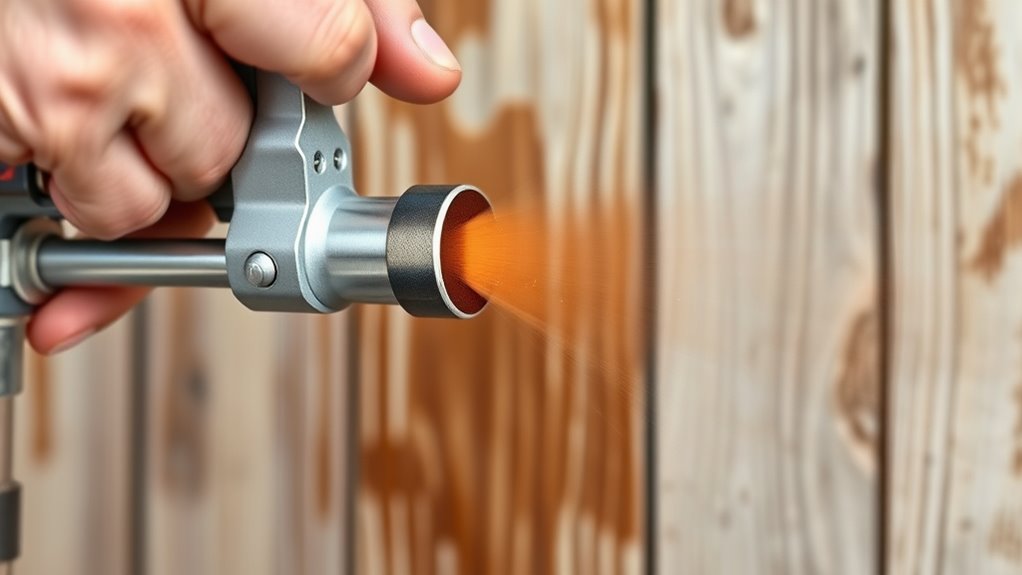
Choosing the right nozzle is essential for achieving smooth, even stains and finishes. You need to contemplate the nozzle size, material compatibility, and how the spray pattern is controlled. Getting these points right will make your project easier and give you professional results. Additionally, considering efficient spray patterns can help optimize the application process and reduce overspray. Furthermore, considering mindful decluttering strategies can help organize your workspace and tools, making your staining and finishing projects more efficient and enjoyable. Being aware of appropriate paint sprayer types can also ensure you select equipment suited for staining or polyurethane applications.
Nozzle Size Selection
How do you determine the right nozzle size for staining or applying polyurethane? The key is matching the nozzle size to the desired spray pattern and finish. A smaller nozzle, like 0.8 or 1.0 mm, produces a finer spray ideal for thin stains or clear coats, giving you better control and detail. Larger nozzles, such as 1.3 or 1.5 mm, create a broader spray pattern perfect for thicker stains or polyurethane, covering more surface quickly. Consider the consistency of your material—thinner stains need smaller nozzles, while thicker finishes require larger ones. Always test your spray pattern on scrap material first to ensure even coverage without drips or runs. Proper nozzle selection is essential for optimal results and minimizing waste. Additionally, understanding nozzle size can help you achieve a professional look and reduce material waste.
Material Compatibility
Selecting the right nozzle depends on the material you’re applying, as different finishes require specific equipment to guarantee ideal results. When working with stains or polyurethane, consider brush types and paint compatibility to assure a smooth application. Some sprayers are better suited for thick materials like stain, which may need a nozzle designed for high viscosity substances. Conversely, polyurethane often requires a nozzle that delivers finer spray patterns for a smooth, even finish. Always check the compatibility of your paint or stain with your sprayer, as using incompatible materials can clog the nozzle or cause uneven coverage. Matching the right nozzle to your material ensures efficient spraying, prevents clogs, and results in a more professional-looking finish. Proper material compatibility is key to successful staining or finishing projects. Additionally, understanding the mechanics of pinball machines can help you troubleshoot equipment issues and select the appropriate sprayer settings for different finishes.
Spray Pattern Control
The spray pattern you choose directly impacts the quality and efficiency of your staining or finishing project. To achieve smooth, even coverage, select a nozzle that creates the right spray design for your task. For detailed areas, a narrower pattern works best, while larger surfaces benefit from a wider spray. Use brush techniques to blend edges and avoid streaks, especially when shifting between stained and unpainted areas. Masking methods help protect surrounding surfaces and ensure clean lines. Adjusting your spray pattern frequently can prevent overspray and uneven coats. Practice on scrap wood to fine-tune your technique and nozzle choice. Mastering spray pattern control ensures a professional finish, minimizes waste, and speeds up your project.
Diluting Stain and Polyurethane for Spraying

Diluting stain or polyurethane before spraying is essential to achieve a smooth, even finish and prevent clogging your spray gun. Proper thinning helps you control the spray pattern and ensures consistent application, which is crucial for color matching. If the mixture is too thick, it can result in uneven coverage and compromised finish durability. Conversely, thinning it too much might cause drips or runs. Typically, you’ll want to add a compatible solvent, such as mineral spirits or water, gradually while stirring until you reach the desired consistency. Testing the mixture on a scrap surface before applying it to your project will help you fine-tune the dilution. This step ensures your stain or polyurethane sprays smoothly, maintains color accuracy, and enhances the overall finish durability.
Techniques for Applying Stain With a Paint Sprayer
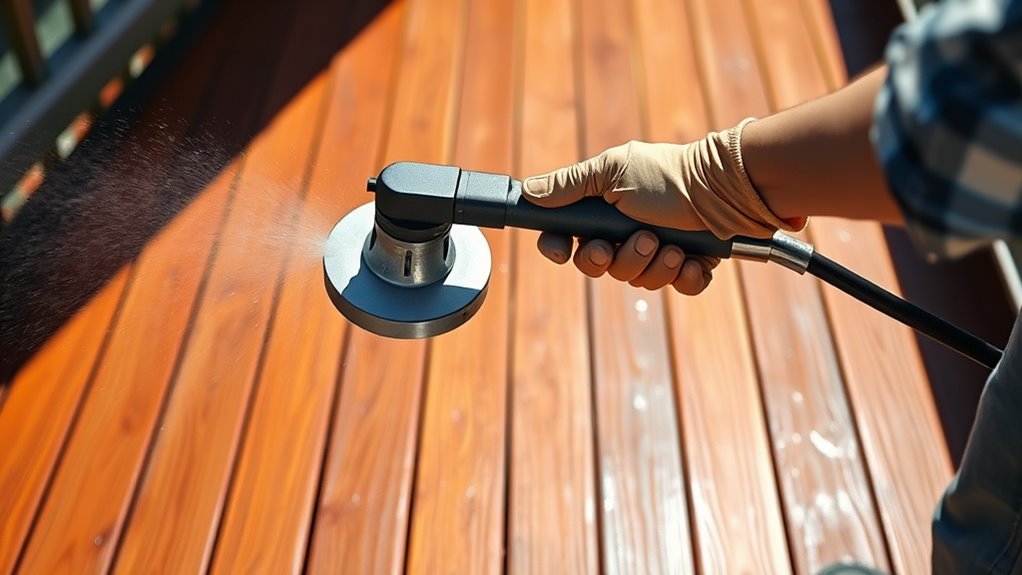
To achieve a smooth, even finish, you need to set your sprayer correctly and follow the best application techniques. Adjust your sprayer settings based on the stain type and project surface for maximum results. Using proper methods will help you apply stain efficiently and avoid drips or uneven coverage.
Proper Sprayer Settings
Achieving a smooth, even stain application with your paint sprayer depends largely on setting it correctly. Start by adjusting the spray pattern to suit the surface’s shape and texture. A narrow fan works well for detailed areas, while a wider spray covers large surfaces efficiently. Set the fluid flow to a low or medium level to prevent oversaturation. Proper surface preparation is essential—clean, sand, and remove dust before you start. Your brush techniques, like maintaining consistent distance and speed, help ensure even coverage. Test your settings on a scrap piece first to fine-tune the spray pressure and pattern. Making these adjustments will give you a professional finish and reduce drips or uneven spots during application.
Optimal Application Techniques
Applying stain with a paint sprayer requires steady, controlled movements to guarantee even coverage and prevent drips. To achieve the best results, focus on these key techniques:
- Maintain a consistent distance from the surface, usually about 12 inches, to ensure uniform application.
- Use smooth, overlapping strokes and incorporate proper brush techniques to blend edges seamlessly.
- Keep drying times in mind; avoid over-spraying to allow sufficient drying between coats, reducing streaks and imperfections.
Applying Polyurethane Using a Sprayer for a Smooth Finish
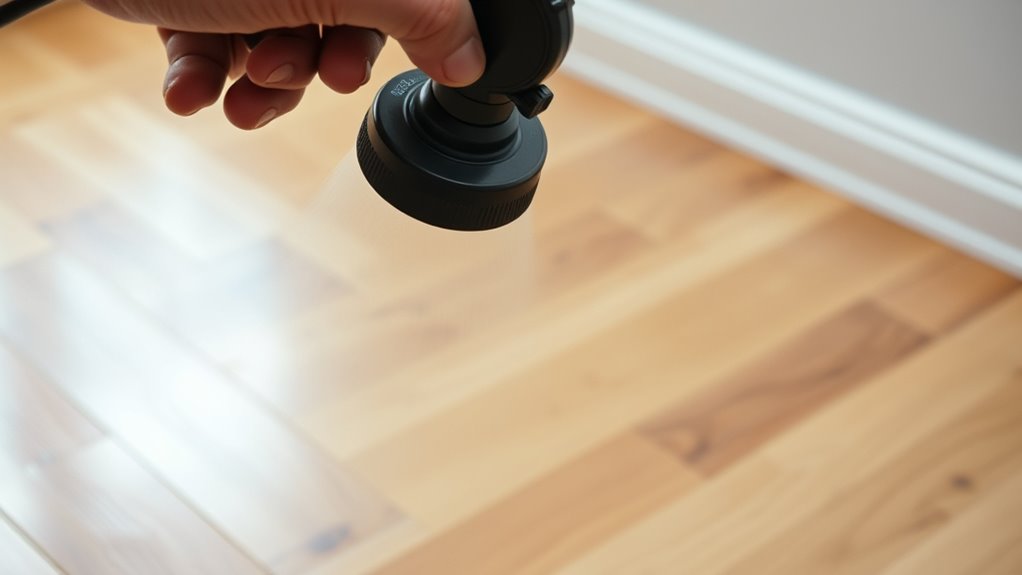
Using a sprayer to apply polyurethane can give you a smooth, even finish that’s hard to achieve with brushes or rollers. To maximize results, maintain consistent distance and speed to prevent drips or uneven coats. Proper brush techniques can help smooth out any inconsistencies, especially around edges. Keep in mind that drying times will vary depending on the spray thickness and environmental conditions; thinner coats typically dry faster. To help you stay organized, here’s a quick comparison:
| Technique | Effect on Finish |
|---|---|
| Steady, even motion | Reduces drips and uneven spots |
| Overlapping strokes | Ensures uniform coverage |
| Light coats | Shorter drying times |
| Consistent distance | Prevents runs and sags |
| Proper ventilation | Accelerates drying |
Following these tips will help you achieve a sleek, professional-looking polyurethane finish.
Cleaning and Maintaining Your Sprayer After Use
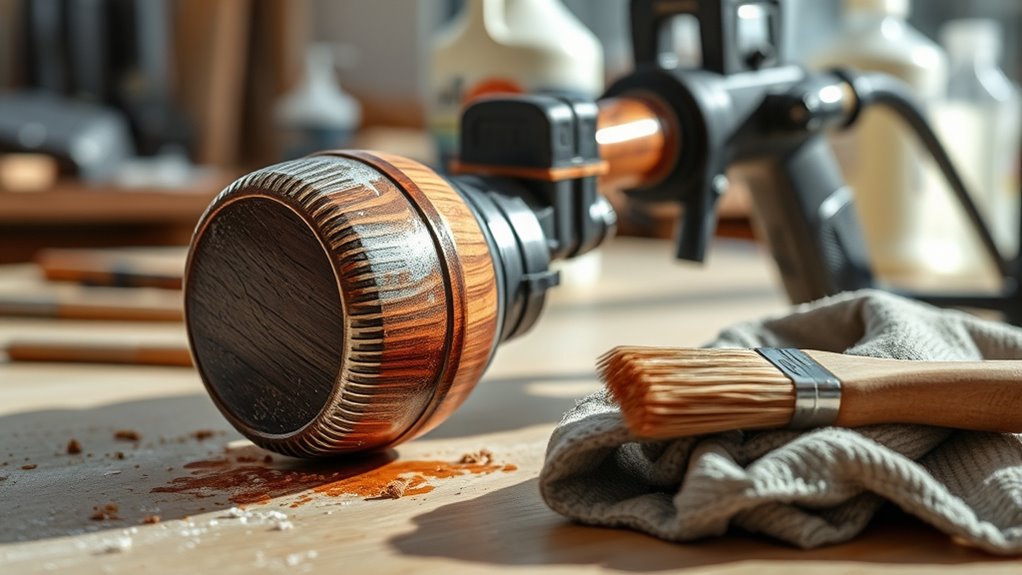
After finishing your spraying session, it’s essential to clean your sprayer thoroughly to guarantee it performs well on future projects. Proper maintenance prevents clogs and extends your equipment’s lifespan. Here are key steps to follow:
- Brush Maintenance: Use a brush to remove any residual stain or polyurethane from the container and external parts, ensuring no buildup.
- Nozzle Cleaning: Remove the nozzle and soak it in solvent, then clear any blockages with a needle or brush.
- System Flush: Run clean solvent or water through the sprayer to clear remaining material, paying attention to the hoses and filters. Regular cleaning prevents clogs and keeps your sprayer functioning smoothly.
Safety Tips and Best Practices for Spraying Different Coatings

Because spraying different coatings can pose unique health and safety risks, it’s essential to take proper precautions before you begin. Always wear appropriate PPE, including masks, goggles, and gloves, to protect yourself from fumes and particles. Make sure your equipment is well-maintained; check hoses, filters, and nozzles for damage to prevent leaks or malfunctions. Use proper ventilation to minimize inhalation risks, especially with solvent-based stains or polyurethane. Follow manufacturer instructions for mixing and application to avoid over-spraying or uneven coats. Regular equipment maintenance not only ensures safety but also improves performance and results. By adhering to safety precautions and maintaining your sprayer, you reduce hazards and achieve a smooth, professional finish on all coatings.
Frequently Asked Questions
Can You Spray Oil-Based Stains With a Standard Paint Sprayer?
You can spray oil-based stains with a standard paint sprayer, but you’ll need to modify your brush techniques and maintain your spray gun properly. Thin the stain to avoid clogging, and clean the spray gun thoroughly after use to prevent buildup. Practice steady, even strokes to achieve a smooth finish. Proper spray gun maintenance ensures consistent results, making your staining project easier and more professional-looking.
Is It Necessary to Thin Polyurethane Before Spraying?
You might think thinning polyurethane isn’t necessary, but surface preparation and equipment maintenance prove otherwise. To spray polyurethane effectively, you should dilute it slightly to ensure smooth application and prevent clogging. Properly prepared, thinned polyurethane flows evenly, reducing brush marks or drips. Always clean your sprayer thoroughly afterward to maintain its performance. Thinning isn’t always required, but it can make your project easier and result in a better finish.
How Do You Prevent Drips and Uneven Coating When Spraying Stain?
To prevent drips and uneven coating when spraying stain, you should focus on your spray pattern and brush techniques. Keep the spray pattern consistent, overlapping each pass slightly to guarantee even coverage. Maintain a steady distance from the surface and avoid stopping in one spot. Use smooth, controlled movements and thin coats to reduce drips. Properly adjusting your spray settings and practicing beforehand also help achieve a flawless finish.
Can You Use the Same Spray Settings for Both Stain and Polyurethane?
You can’t use the same spray settings for both stain and polyurethane because their spray techniques and viscosities differ. For the best results, adjust your sprayer’s pressure and nozzle to match each product’s needs. Proper surface preparation is essential for even coating, and tweaking your settings ensures a smooth finish. Always test on a scrap piece first to avoid drips or uneven coverage, especially when switching between stain and polyurethane.
What Safety Gear Is Recommended When Spraying Stains and Polyurethanes?
When spraying stains or polyurethanes, safety should be your top priority. You’ll want to wear protective gloves to guard your skin from chemicals, and a respiratory mask to prevent inhaling fumes and particles. These safety gears work together, ensuring you stay safe while achieving a smooth, professional finish. Remember, proper safety equipment not only protects you but also helps you work more efficiently and confidently.
Conclusion
Now you know that paint sprayers can indeed handle stain and polyurethane, but preparation is key. Adjust your settings, choose the right nozzle, and follow proper techniques for a flawless finish. Remember, a well-maintained sprayer and safety precautions are essential. As the saying goes, “A stitch in time saves nine”—taking the extra effort guarantees your project turns out beautifully and lasts longer. Happy spraying!
Franz came aboard the Paint Sprayer Zone team with a background in both journalism and home renovation. His articulate writing style, combined with a passion for DIY projects, makes him an invaluable asset. Franz has a knack for breaking down technical jargon into easy-to-understand content, ensuring that even the most novice of readers can grasp the complexities of paint sprayers.
